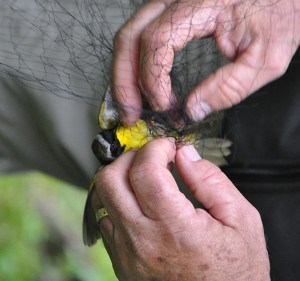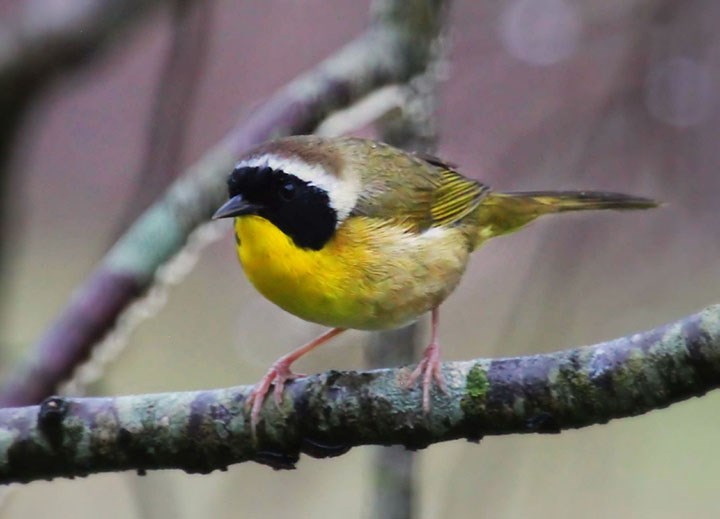The male common yellowthroat is the Zorro of the warbler family, his dark black mask a sharp contrast to his yellow and olive-coloured body. This time of year he duels with other males, establishing territories and fighting for mates. He will lure the ladies with his lilting warble, and outside of his romances can be found hunting insects and spiders in the dark tangle of low plants along side ponds and meadows. Having indulged his dalliances, soon he will leave Jasper for an exotic southern location.
At least that’s what we hope he will do. In reality, the flight of Zorro is perilous, as it is for any migratory bird. He must avoid the siren call of brilliantly lit skyscrapers, dodge backyard cats, and avoid the whirling chop of wind farms. He will look for wetlands to feed beside, and find less of them than generations before him. Poor water quality, pollution, and pesticides are threats his little masked eyes may not detect.
The number of threats he faces, and how often, depends on the population of common yellowthroats Zorro hails from. Populations are genetically related groups within a species. They tend to use the same general breeding areas each year, often in very different parts of North America. Scientists like Kristin Ruegg, assistant adjunct professor at the University of California at Los Angeles (UCLA), wants to identify these important areas so that threats can be identified and addressed at a population-specific level.
It makes sense, as animals tend to be managed on a population by population basis, says Ruegg. “As a whole, a species might be doing okay. However we may see a population decline in one region. Managers want to know what’s going on there so they can put resources toward it.”
Along with UCLA professor Tom Smith, Ruegg co-directs the Bird Genoscape Project, with the long-term ambition of mapping the population-specific migratory routes of 100 species of songbirds. The first step in this process is to create maps called “genoscapes” that outline the breeding ranges of birds at a population level. Efforts to map breeding populations of common yellowthroats are underway, and Parks Canada will lend a hand.
Jasper National Park ecologist Brenda Shepherd and volunteers from the Friends of Jasper will collect genetic information (feathers and blood) from our local Zorros and their girlfriends to help build the common yellowthroat map. Shepherd already monitors bird breeding success and survivorship as part of a continent- wide program to collect data on birds, developed by the Institute for Bird Populations (IBP).

None of this would happen without partners like Shepherd and the IBP, says Ruegg. With funding from the California Energy Commission, the project is a collaboration of numerous scientists and conservation organizations across North America.
Once the breeding map is complete, genetic information collected from common yellowthroats along their migration route can be analyzed and linked back to a specific breeding population. This will help Ruegg and her team establish migration patterns. Getting a DNA sample is often as simple as the collection of a feather. To date, more than 180,000 feathers from North, Central and South America have been sent to the Genoscape Project.
Feathers come from all over: bird-banding stations, researchers, and partners like Audubon’s Lights Out Project, aimed at reducing bird collisions with buildings. Lights Out volunteers get up early and walk around the base of skyscrapers throughout the USA, picking up dead birds in the hope of learning which populations are most vulnerable.
“The common yellowthroat is one of the main species collected by Lights Out volunteers across the [USA],” says Ruegg. Feathers collected from those bird carcasses can tell her what breeding population the bird belongs to, and provide a location along their migration route. The more locations they collect from, the better the understanding of migration patterns.
When scientists and land managers have a more detailed understanding of how populations move, they will be better equipped to understand how larger pressures, like climate change, affect bird populations throughout their yearly migratory cycle.
In the meantime, Zorro continues to romance the ladies, unaware of the challenges he’ll face when he travels south. It’s a good thing people like Ruegg are working toward understanding–and maybe someday mitigating–his migration woes so he can continue his yearly journey as an international man-bird of mystery. Even Ruegg is not immune to his charms. “That little black mask is pretty damn cool.”
Niki Wilson | Special to the Fitzhugh

